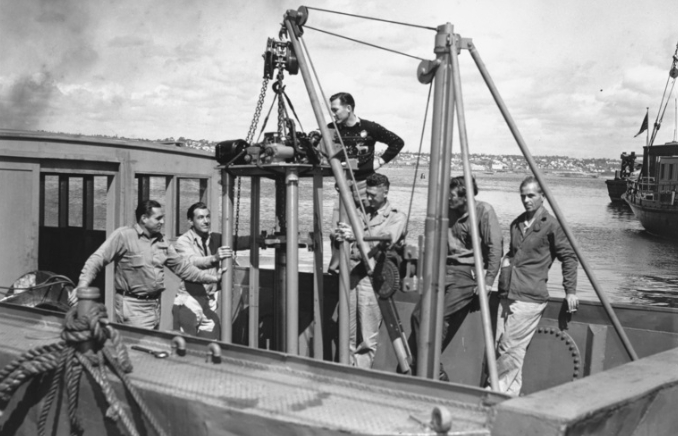This piece is from SD HistCon founder Harold Buchanan. This is the first piece in a six-part series looking at the history of San Diego in World War II. Expect a new post in this series each Monday for the next six weeks. Harold is an award-winning designer whose designs include Liberty or Death (2016), Campaigns of 1777 (2019), and Flashpoint: South China Sea (2022). He has been a historical gamer since 1979. Harold is an Adjunct Professor of Finance at The University of California San Diego.
Japan attacked Pearl Harbor on Sunday, December 7, 1941 at 10:48 AM Pacific Time. Shaken, San Diego looked west for news about the damage to the Pacific Fleet. It took days for the extent of the death and damage to become clear.
San Diego lay exposed, and generally as unprepared as was the Hawaiian islands. The community was near panic as authorities scrambled to defend the harbor, city and coast. Emergency plans were poorly coordinated and impossible to implement. The only defensive measure to succeed on that fateful Sunday was closure of the harbor.

Torpedo nets in the San Diego harbor.
On December 8, 1941 at 1:10 p.m. Pacific Time, President Franklin D. Roosevelt’s official declaration of war was signed. San Diego quickly mobilized to defend the city and its surrounding coastal communities. Military bases and camps expanded still further as tens of thousands of young men and women arrived for training before going overseas.
San Diego was already supporting the war in Europe with a rapid expansion of manufacturing of supplies and weapons. That machine found another gear after the Pearl Harbor attack.

The San Diego Union-Tribune after the Pearl Harbor attack.
The connection to the Pearl Harbor attack was intensely personal for San Diego. Many of the American sons and daughters that were victims of the Japanese attack were either from California or had lived and trained in San Diego. In the year before the attack, the Pacific Fleet had transferred command from San Diego to Pearl Harbor. Admiral Isoroku Yamamoto and Captain Mitsuo Fuchida and other commanders of the Japanese task force attacking Pearl Harbor had attended flight training in San Diego just two decades before.
Many of the ships that were present at Pearl Harbor were subsequently rebased to San Diego for repairs and refitting, including the battleships USS California, USS West Virginia, and USS Nevada. As an interesting postscript,on April 18, 1943, a San Diegan, Thomas George Lanphier Jr., shot down Admiral Yamamoto over the Solomon Islands in the South Pacific.
The following series outlines just some of the ways World War II impacted the San Diego community. Many of these impacts remain in physical form; a testament to the resilience and strength of this once-quiet (and hopefully continuing to be so) border town.
First, we will cover the University of California’s Division of War Research at Scripps Institute, which later bore the University of California San Diego. Next, we will talk about commercial contributions from both the San Diego tuna fleet and Consolidated Aircraft Corporation. We will then have a discussion of bases in or near San Diego and some of the physical memories that remain. And finally, we will close with a discussion of the physical manifestations of conflict in the San Diego area. Here’s the first piece, on that Division of War Research, with others to follow in the coming weeks.

WWII propaganda posters.
Part 1 of 6: The University of California’s Division of War Research: Anti-Submarine Warfare Advancements during World War II
The University of California’s Division of War Research (UCDWR) isn’t as widely recognized as other wartime efforts. But it played an important role during World War II, specifically in advancing anti-submarine warfare technologies.

A San Diego WWII image.
With the growing threat from Axis powers, particularly in the Pacific with Japanese submarines, there was an urgent need for the United States to enhance its anti-submarine warfare capabilities. To address this, the UCDWR was established in 1943 at the Scripps Institution of Oceanography in La Jolla, San Diego.
The primary focus of the UCDWR was to conduct scientific and technical research to counter the submarine threat. The division’s location at the Scripps Institution of Oceanography was strategic, given Scripps’ focus on oceanographic research. The UCDWR focused on the following areas:
- Sound Propagation: Sound waves behave differently in water compared to air, and their behavior can be affected by factors like water temperature, salinity, and depth. UCDWR researched these aspects to improve sonar technologies.
- Echo Ranging: One of the division’s breakthroughs was in echo ranging techniques. This allowed naval vessels to detect and track enemy submarines with improved accuracy.
- Underwater Explosions: The division studied the effects and dynamics of underwater explosions, aiming to optimize the effectiveness of depth charges and other anti-submarine weaponry.
- Personnel: The division attracted top scientists and engineers from across the nation. This multi-disciplinary team collaborated on various projects and made significant contributions to the field.
Role of Women and Minorities at UCDWR:
While the contribution of women and minorities to the broader war effort—both on the front lines and the home front—is well-documented, specific details about their roles within the UCDWR are not as prominently documented.
Women took on various roles within the UCDWR, ranging from clerical and administrative tasks to technical roles, such as lab technicians, draftsmen, and perhaps even researchers.

A UCDWR office.
Minorities also found new opportunities due to the war, but they still faced significant barriers and discrimination. Minorities were employed in various capacities at the UCDWR, but their roles were more limited than those of their white counterparts.
San Diego, being a military hub during WWII, saw an influx of workers from diverse backgrounds contributing to various war-related efforts. The aircraft industry, shipbuilding, and other defense sectors in the area employed significant numbers of women and minorities. While the UCDWR was more specialized, it mirrored broader societal trends to some extent.

UCDWR personnel.
After the war, the focus of the UCDWR naturally shifted. But its impact on naval warfare and oceanographic research was lasting. The advancements in underwater acoustics and other related fields continued to benefit both military and civilian research in oceanography and marine biology.

The UCDWR was established in 1943 at the Scripps Institution of Oceanography in La Jolla, San Diego.
In essence, the UCDWR exemplifies how scientific research and collaboration can significantly influence warfare and defense strategies. Through its work, the division bolstered the U.S. Navy’s capabilities in the Pacific theater, playing a pivotal role in neutralizing the submarine threat during WWII.
You can follow Harold on Twitter here.
